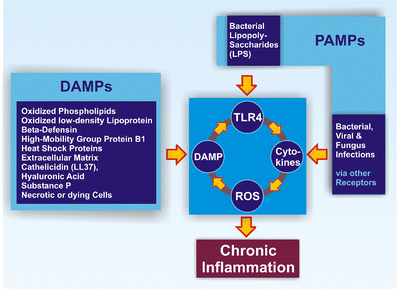Regulatory checkpoints in the Toll-like receptor (TLR) pathway. Subsequent to stimulation with their cognate ligands, TLRs induce several mediators converging at nuclear factor-κB (NF-κB), which mobilizes the transcription of inflammatory genes. This helps the host prepare to fight the microbial threat. After eliminating the threat, the cell must turn off the expression of inflammatory mediators. Sustained activation and overactivation of TLRs are usually accompanied by deleterious consequences for the host.
To prevent these consequences, the cell employs a variety of mechanisms to regulate TLR signaling, including decoy factors, adaptor modification, ubiquitin-mediated degradation, promoter state alteration, and translation disruption. All these mechanisms, individually or in combination, exert the effect of controlling inflammation and supporting the system to regain its normal state (arrows in red indicate the irreversible regulation, whereas the others show the reversible regulation).
If the immune system does not respond appropriately during a bacterial challenge, septic shock occurs, leading to multiple organ failure and death of the host. Sustained activation and overactivation of TLRs also results in the pathogenesis of autoimmune, chronic inflammatory, and neoplastic diseases. Therefore, pro- and anti-inflammatory responses must be balanced. Treatment with soluble receptors is one such physiological approach for modulating the immune response.
...
These studies have unveiled the role of TLRs in inflammation as well as the undesired roles of TLRs in several inflammatory diseases. Overactivation of TLRs disrupts homeostasis and places the patient at an increased risk of developing autoimmune diseases. To control hyper-responses, cells have evolved different mechanisms to protect the host, involving a plethora of molecules. At different stages, different molecules prevent the excessive secretion of inflammatory mediators and assist the immune system in restoring homeostasis. In the absence of these regulatory molecules, fatal consequences are inevitable
...
During homeostasis, when pathogen/damage-associated molecular patterns (PAMPs/DAMPs) breach the protective barrier, TLRs sense these patterns and mount an inflammatory response. As part of the inflammatory response, TLRs activate negative regulators, which have also shown to be triggered by inflammatory cytokines. The inflammatory response neutralizes the danger, and negative regulators prevent the overactivation of the immune system to protect the host. In the case of lack of appropriate TLR stimulation, the propagation of signals, or the induction of an inflammatory mediator, bacteremia may occur, whereas overactivation of any component leads to the development of inflammatory diseases and septic shock.



